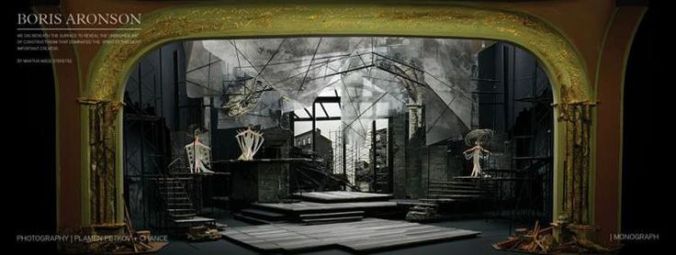Boris Aronson is widely considered as one of the greatest innovators in American Theatre for scenic design. He came to New York in 1923, and immediately established himself by bringing Russian constructivism to a seemingly naturalistic America. During the 1920s, the main style being used by playwrights and various theatre groups was naturalism. Naturalism was considered to be a “slice of life” and was aimed to represent a portion of reality life on-stage. Naturalism was a response to 19th century melodrama and realism. Realism was aimed to exactly represent real life, and was the immediate response to melodrama. Melodrama was considered by many to be “over-the-top”. The melodramatic style embraced many real life undertones and themes, yet the acting and spectacle were not considered to be realistic; it was meant to entertain the audience.

Follies set by Boris Aronson (1971)
Aronson introduced a new type of scenic design that had never been seen in American theatre. Based on his upbringing in Russia and his influence from Meyerhold and Tairov, Aronson introduced Russian constructivism to American Theatre in the 1920s. The Russian style was considered to be an early rebellion to naturalism, and resembled many aspects of symbolism and expressionism, which would be seen later in the mid-20th century.
Though constructivism didn’t last long from a timeline perspective its’ impact was greatly felt in stage design. Constructivism “was a major contributor towards theatricality over illusion, and was especially notable for settings that sat like islands in the midst of the stage with no connection, literally, and metaphorically,” (1100 Banham). Aronson was one of the first to embrace this style through his works.

Set for Diary of Anne Frank (1955)
However, Aronson quickly realized when he came to the United States that naturalism was the dominant style in American theatre. Therefore, Aronson was forced to blend his imaginative set, with a set that seemed realistic. This idea was considered to be a gamble at the time, but once he perfected his blend of the two styles he immediately rose to fame. His innovative technique would impact other scenic designers for years to come; he essentially changed the way audiences would see the “environment” of a story.
Constructivist theatre sets typically included treadmills, ramps, catwalks, trapezes, turning wheels, multiple levels and machines; all of which Boris used throughout his productions in the United States. The set clearly distinguished from the stage. The stage was simply used as the ground or foundation of the set.

Cabaret (1966) by Boris Aronson. * Notice the reflective mirrors above.